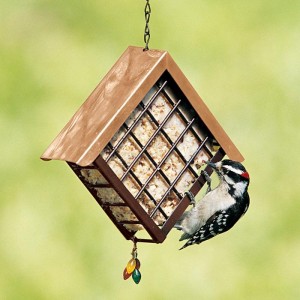It’s brutal out there. We’re in the dog days of summer and the heat is suffocating. I’ve been going anywhere I can that has air conditioning, so I can only imagine what the birds are going through.
The heat itself presents tons of problems for birds, including a lack of water, but one problem people with suet feeders will have is melting suet.
When temperatures exceed 90 degrees, suet quickly becomes a mess. Here’s how to stop that from happening.
Why melted suet is bad for birds
Many people stop putting out suet for birds once winter ends. This is perfectly fine. The high-calorie mixture of fat, seeds, fruits, and insects is important to birds during the winter—that’s when high-energy diets are essential for surviving the cold weather.

However, birds also need more energy during spring and summer. In spring, birds expend energy while nesting. In summer, insects may be less abundant.
But when temperatures are soaring, suet becomes susceptible to melting. Why is that bad?
To start, the heat causes suet to spoil much quicker than it normally would. That results in bacteria growth, which could cause birds to get sick. Not only that but the stench of spoiled suet becomes overwhelming—upsetting neighbors and attracting pests.
Melted suet is also wasted suet. Feeding birds is a great hobby, but it can be expensive. When suet melts or is no longer edible, that’s money and time down the drain.
On top of that, suet that drips on the ground has the potential to cause damage to plants, concrete, and even the birds themselves.
Keeping suet from melting
No-melt recipes
If you buy your suet from a store, many places offer no-melt suet options. They do this by using suet dough with a much higher melting point than average suet. Alternatively, you can make your own suet using a no-melt recipe. The no-melt suet recipe over at the Birders Report is excellent.

Keep suet out of the sun
The difference between the direct sunlight and the shade can be anywhere from 10 to 15 degrees. By choosing to put your suet feeder in the shade instead of the direct sunlight, you can limit its susceptibility to melting.
Make serving sizes manageable
The more suet you put out, the longer it’ll take for birds to eat it. That leaves more exposure to the heat and increases the likelihood that the suet will melt. Only put out enough suet for one day.


